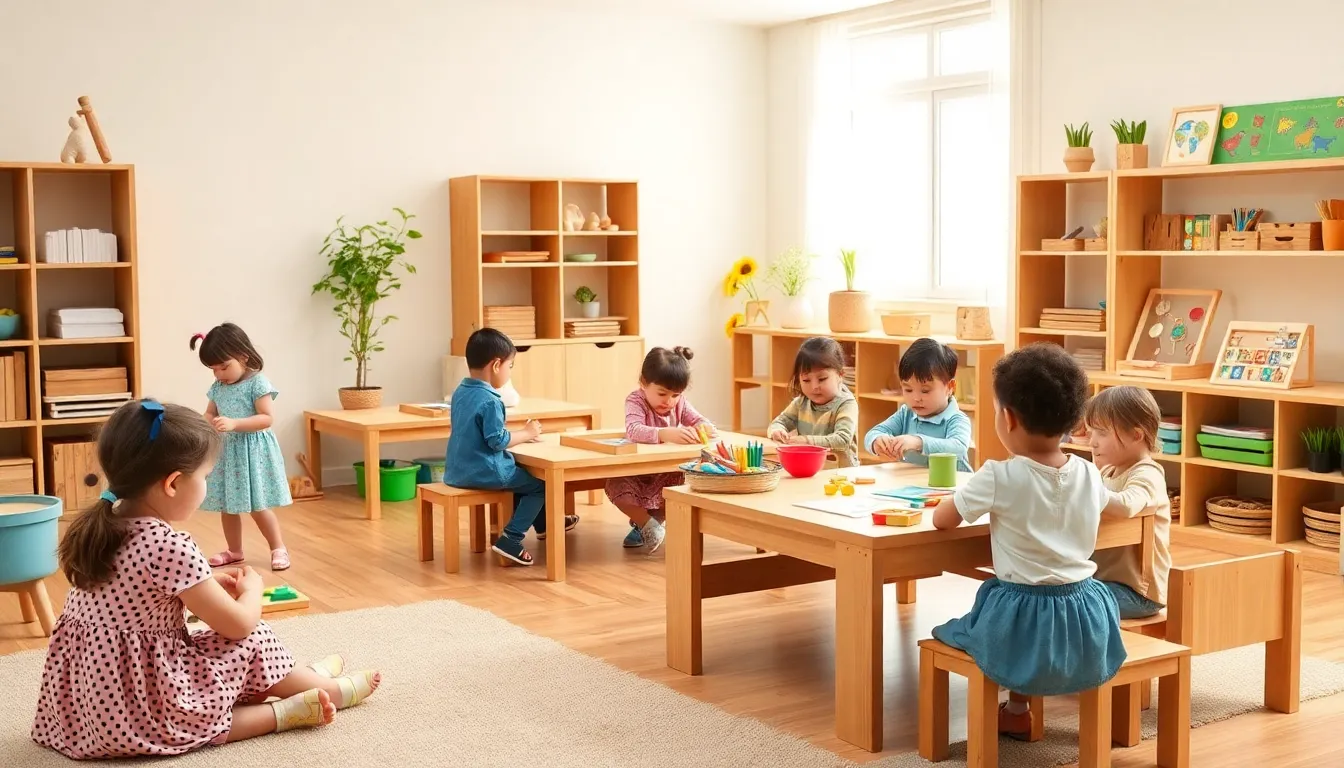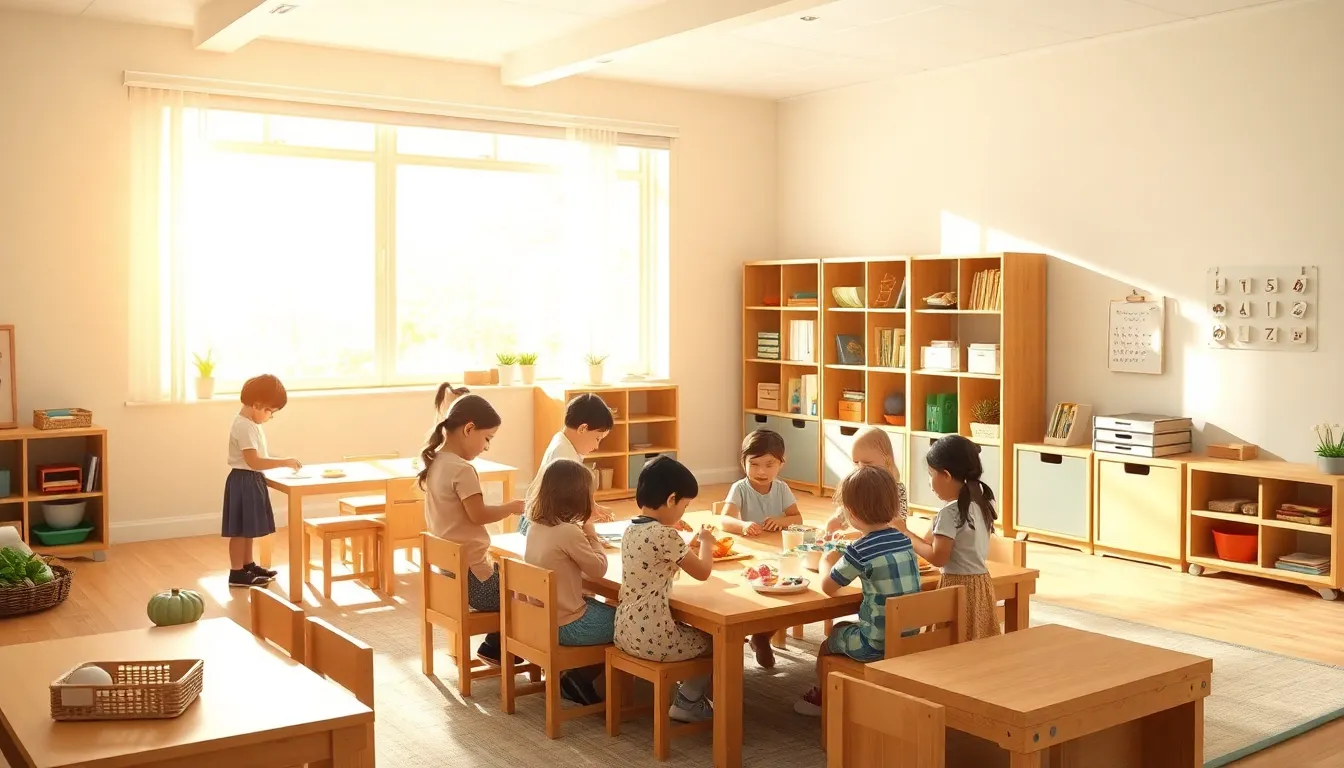Table of Contents
ToggleImagine a world where kids learn at their own pace, surrounded by vibrant colors and engaging materials that spark their curiosity. Welcome to the Montessori environment—a magical realm where education feels less like a chore and more like an adventure. In this unique setting, children aren’t just passive recipients of knowledge; they’re explorers, problem solvers, and mini Einsteins in the making.
Overview of Montessori Environment
The Montessori environment fosters independence and promotes self-directed learning. This setting comprises carefully chosen materials that cater to various developmental stages. These materials encourage hands-on exploration and critical thinking skills.
Classrooms often include distinct areas, such as practical life, sensorial, mathematics, language, and cultural studies. Each area contains age-appropriate resources that engage children in different learning experiences. Children can choose activities they find interesting, which enhances their intrinsic motivation.
Natural light plays a crucial role in the Montessori environment. Ample lighting creates a warm and inviting atmosphere, making it easier for children to focus on their tasks. Open spaces promote movement and interaction, supporting social development and collaboration.
Furniture in Montessori classrooms is child-sized and functional. This design allows children to access materials independently and encourages responsibility for their environment. Each child learns to care for the space, reinforcing respect for others and themselves.
In addition, the prepared environment emphasizes order and beauty. The arrangement of materials follows a logical sequence, allowing children to make connections between concepts. A visually appealing environment fosters concentration and a sense of peace.
Educators in Montessori settings act as guides rather than traditional instructors. They observe children’s interests and developmental needs, facilitating learning opportunities. This approach nurtures a lifelong love of learning and allows children to flourish.
Overall, the Montessori environment represents a holistic educational approach that honors each child’s unique journey. By emphasizing autonomy, collaboration, and respect, it prepares children for future academic, social, and emotional success.
Key Components of Montessori Environment

The Montessori environment consists of several key components that facilitate optimal learning experiences for children. Each aspect plays a crucial role in fostering independence and exploration.
Prepared Environment
The prepared environment is fundamental in Montessori settings. Classrooms feature distinct learning areas, encouraging children to explore various subjects. Natural materials and beautiful aesthetics create an inviting atmosphere. Thoughtfully arranged resources promote order and ease of access, allowing children to choose activities independently. This setup nurtures autonomy and self-directed learning. Educators carefully monitor the environment, adjusting materials based on children’s developmental needs, enhancing engagement and exploration.
Role of Materials
Materials in the Montessori environment serve specific educational purposes. Each resource is designed for hands-on learning and aligns with children’s developmental stages. For example, sensorial materials refine perceptions and critical thinking skills. Practical life resources build everyday skills and promote responsibility. Language and mathematics materials encourage foundational skills through interactive play. Children engage deeply with these materials, exploring concepts at their own pace. This engagement fosters a love for learning and motivates children to pursue their interests further.
Benefits of a Montessori Environment
The Montessori environment offers numerous benefits that support children’s growth and development.
Fostering Independence
Independence thrives within a Montessori setting. Children engage in self-directed activities that promote personal responsibility. They learn to choose tasks based on their interests, enhancing decision-making skills. Self-sufficiency results from hands-on materials designed for various developmental stages. Access to child-sized furniture further encourages autonomy, allowing children to move freely while accessing resources. Such freedom fosters confidence, as they gain mastery over their surroundings. Educators guide rather than direct, fostering an atmosphere where children take ownership of their learning experiences.
Encouraging Exploration
Exploration plays a vital role in the Montessori framework. Each prepared area invites curiosity and creativity, sparking children’s instincts to discover. Distinct learning areas—such as practical life and sensorial—offer diverse resources for hands-on engagement. Children select activities that resonate with them, reinforcing intrinsic motivation. Open spaces and natural light create an environment conducive to investigation. Materials are intentionally arranged to promote connections between concepts. Young learners engage deeply with resources, fostering critical thinking and problem-solving skills. This exploration-first approach cultivates a lifelong love for learning as they expand their understanding of the world.
Challenges in Implementing Montessori Environment
Challenges exist in creating an effective Montessori environment. Training educators poses a significant hurdle, requiring specialized knowledge and continuous professional development. Many traditional teacher preparation programs do not cover Montessori methods, leaving educators unprepared to implement core principles. As a result, investment in training is essential to ensure teachers can guide children effectively. Ongoing workshops and mentorship improve teachers’ skills and deepen their understanding of child-led learning.
Adapting to different learning styles adds complexity to implementation. Each child’s unique learning preferences must be accounted for to foster engagement. Montessori environments promote independence, but flexibility remains crucial. Not all children thrive within the same structure, making it vital to assess and adapt materials and activities according to individual needs. This can involve modifying lessons or using alternative resources to cater to diverse learners, ensuring every child receives relevant and effective educational experiences.
The Montessori environment stands out as a transformative approach to education that nurtures children’s natural curiosity and independence. By creating spaces that invite exploration and self-directed learning, it empowers children to take charge of their educational journeys.
This holistic setting not only fosters critical thinking and problem-solving skills but also instills a lifelong passion for learning. While challenges exist in training educators and adapting to individual learning styles, the benefits of a well-implemented Montessori environment are undeniable.
Ultimately, it lays a strong foundation for children’s future academic and social success, equipping them with the skills they need to navigate the world with confidence and creativity.





